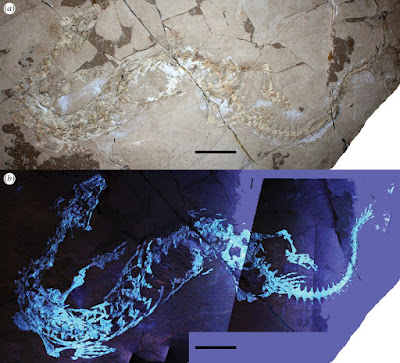 |
| Primitivus manduriensis
Paparella, Palci, Nicosia & Caldwell, 2018
|
Abstract
A new marine lizard showing exceptional soft tissue preservation was found in Late Cretaceous deposits of the Apulian Platform (Puglia, Italy). Primitivus manduriensis gen. et sp. nov. is not only the first evidence of the presence of dolichosaurs in a southern Italian Carbonate Platform, filling a palaeogeographic gap in the Mediterranean Tethys, but also extends the range of this group to the upper Campanian–lower Maastrichtian. Our parsimony analysis recovers a monophyletic non-ophidian pythonomorph clade, including Tetrapodophis amplectus at the stem of Mosasauroidea + Dolichosauridae, which together represent the sister group of Ophidia (modern and fossil snakes). Based on Bayesian inference instead, Pythonomorpha is monophyletic, with Ophidia representing the more deeply nested clade, and the new taxon as basal to all other pythonomorphs. Primitivus displays a fairly conservative morphology in terms of both axial elongation of the trunk and limb reduction, and the coexistence of aquatic adaptations with features hinting at the retention of the ability to move on land suggests a semi-aquatic lifestyle. The exceptional preservation of mineralized muscles, portions of the integument, cartilages and gut content provides unique sources of information about this extinct group of lizards. The new specimen may represent local persistence of a relict dolichosaur population until almost the end of the Cretaceous in the Mediterranean Tethys, and demonstrates the incompleteness of our knowledge of dolichosaur temporal and spatial distributions.
KEYWORDS: Squamata, Pythonomorpha, Apulian Platform, Cretaceous, soft tissue, ultraviolet radiation
Systematic palaeontology
Reptilia Linnaeus, 1758
Squamata Oppel, 1811
Pythonomorpha Cope, 1869
DOLICHOSAURIDAE Gervais, 1852
Definition. Dolichosauridae is here defined as the group including all taxa sharing a more recent common ancestor with Dolichosaurus longicollis than with Aigialosaurus sp. In our study, this includes the following genera: Dolichosaurus, Pontosaurus, Primitivus gen. nov., Adriosaurus, Acteosaurus, and Aphanizocnemus (cf. Nopcsa [1903] and Conrad [2008]).
Diagnosis. Dolichosauridae is here defined as the group of non-ophidian pythonomorphs characterized by the following combination of features: non-sutural contact between premaxilla and maxilla; jugal lacking large posterior process; postorbital portion of postfrontal + postorbital forming half or more of the posterior orbital margin; hypapophyses/hypapophyseal peduncles extending to the tenth presacral/precloacal vertebra or beyond (10–12 cervical vertebrae); 32–40 presacral/precloacal vertebrae; reduced scapula and coracoid; tail deep, laterally compressed (cf. Pierce & Caldwell [2004], Caldwell [2006,2000], Palci & Caldwell [2010]).
Primitivus manduriensis gen. et sp. nov.
Etymology. The genus is named after the famous red wine grape variety, ‘Primitivo’, native to and grown in great quantities in the Salento Peninsula (Puglia, southern Italy). The species name has been chosen to honour the full name of the wine, ‘Primitivo di Manduria’, which is not only produced around the town of Manduria (Taranto, Puglia), but also in other localities of the Salento Peninsula, including Nardò, where the specimen was found.
Holotype. MPUR NS 161, an almost complete skeleton mostly in articulation, exposed in dorsal view, partially embedded in the rock, and missing the terminal portion of the tail and some elements of the skull. Together with the skeleton, there are abundant soft tissues preserved, including permineralized muscle fibres and integument.
Locality and stratigraphy. Nardò, Lecce (Puglia, southern Italy); higher portion of the informal geological unit ‘Calcari di Melissano’, Apulian Carbonate Platform.
Age. Upper Campanian–lower Maastrichtian, based on microfossils.
Diagnosis. The new taxon can be distinguished from other dolichosaurids by the following unique combination of features: contact between frontal and prefrontal limited in the dorsal view; sutural contact between the septomaxilla anterolateral margin and the maxilla; the septomaxilla posterolateral margin in contact with the nasal; 10 cervical vertebrae + 22 dorsal vertebrae (32 presacrals); bowtie-shaped astragalus (with both a dorsal and a ventral notch); calcaneum with a proximal concavity for articulation with the fibula; deeply imbricated, small sub-circular scales on the lateral sides of the trunk and limbs; larger diamond-shaped scales on the trunk dorsal region; transversally expanded subcaudal scales.
Ilaria Paparella, Alessandro Palci, Umberto Nicosia and Michael W. Caldwell. 2018. A New Fossil Marine Lizard with Soft Tissues from the Late Cretaceous of southern Italy. Royal Society Open Science. DOI: 10.1098/rsos.172411


